Road
BELO BLATO, IN BANAT, AT THE END OF THE ROAD
A Reed Village
Between the Begej and the Tisa, between Carska bara and fish pond ”Ečka”, cowering at the foot of the embankment, several meters below the lake water level, this village has for decades lived almost exclusively from reed. About 1,500 inhabitants and about fifteen ethnicities are being educated in three languages. Some of them take the only way there is to the wide world, the others stay in Belo Blato to continue the old ancestral reed dreams and to make new export deals. Because, trucks from several Western European countries often wait in queues for the new supplies of reed
By: Vladimir Putnik
Photographs: Dragan Bosnić
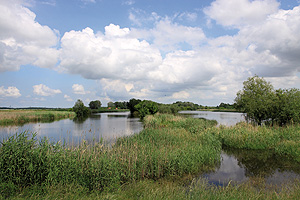 Travelling from Belgrade toward Zrenjanin, you pass Besni Fok, Čenta, intersection for Perlez, and then a little before Stajićevo you turn left. Exactly at the place where beautify decorated ”Tiganjica” is located, an ethno center with a good restaurant, old Banat houses, ethno sculptures, a zoo and a windmill. Soon you pass by the Begej, wondering whether that river flows at all or whether, lazy and sleepy, it has fully succumbed to the rhythm of the nearby Carska bara (remained in the old basin of that same river). You keep going straight, not more than a kilometer. The road goes up on the embankment. On the left side, there is a Special Natural Reservation ”Carska bara”, on the right side a huge fish pond ”Ečka”, actually a lake, with surface area of about 2,000 hectares. Travelling from Belgrade toward Zrenjanin, you pass Besni Fok, Čenta, intersection for Perlez, and then a little before Stajićevo you turn left. Exactly at the place where beautify decorated ”Tiganjica” is located, an ethno center with a good restaurant, old Banat houses, ethno sculptures, a zoo and a windmill. Soon you pass by the Begej, wondering whether that river flows at all or whether, lazy and sleepy, it has fully succumbed to the rhythm of the nearby Carska bara (remained in the old basin of that same river). You keep going straight, not more than a kilometer. The road goes up on the embankment. On the left side, there is a Special Natural Reservation ”Carska bara”, on the right side a huge fish pond ”Ečka”, actually a lake, with surface area of about 2,000 hectares.
”Good morning! Belo Blato?”
Almost sixty years old, he stops his bicycle near the curb, pulls his hat to the back of his head, and points straight ahead.
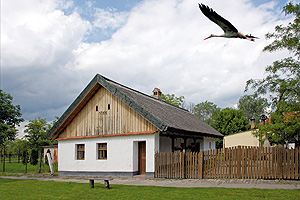 ”Go straight for another three kilometers, over the embankment”, he says. With strong Hungarian accent. ”You can’t miss it: it is the only road, and when you reach Belo Blato, that will be the end of the road.” ”Go straight for another three kilometers, over the embankment”, he says. With strong Hungarian accent. ”You can’t miss it: it is the only road, and when you reach Belo Blato, that will be the end of the road.”
We enter the village suddenly, it seems, through a long straight street. A beautiful alley of trees on both sides of the road: at equal distance from one another, symmetrical, identical trees. Tree trunks painted white, beautifully shaped treetops. It goes to the infinity, it seems. We will learn afterwards that these unknown trees are actually the Siberian elm. They could not tell us exactly who brought it here, when, who planted it so neatly, but it seems that it was not by accident that this person chose the variety hardened in conditions so cruel as those in Siberia.
BEAUTY OF THE SUMMER IN A VILLAGE
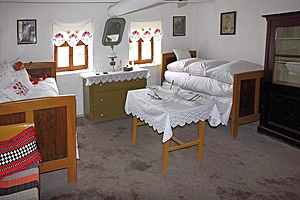 Nicely painted houses, washed windows, grass along the street recently cut, cascades of flowers on all sides. It seems idyllic in a way, this village at the end of the road. While following the sign for ethno house ”Belo Blato” from 1866, we realize that we stumbled into this village on a Sunday afternoon and that decent local people are now napping after a plentiful lunch, watered down with a jug of chilled wine. There are no devils that drive them, like they drive us, people born in or accustomed to the city. That is why there are very few people on the streets. Here and there a kid would ring on his bike, as if a bird has just flown, or some young folk who can finally enjoy the school break and the summer would run by. Nicely painted houses, washed windows, grass along the street recently cut, cascades of flowers on all sides. It seems idyllic in a way, this village at the end of the road. While following the sign for ethno house ”Belo Blato” from 1866, we realize that we stumbled into this village on a Sunday afternoon and that decent local people are now napping after a plentiful lunch, watered down with a jug of chilled wine. There are no devils that drive them, like they drive us, people born in or accustomed to the city. That is why there are very few people on the streets. Here and there a kid would ring on his bike, as if a bird has just flown, or some young folk who can finally enjoy the school break and the summer would run by.
”No, you do not exaggerate”, this ‘village at the end of the road’ is really a little idyllic and even unique in certain ways”, says with a smile Milena Goda, the hostess at the Ethno House, for us an unexpected hostess in the entire Belo Blato. She works as a clerk at the village elementary school, but she also takes care about the Ethno House, which is located within the school yard. ”This layout that we made is a reconstruction of traditional Banatian house from the seco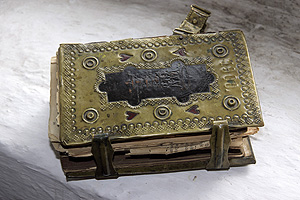 nd half of the 19th century. There is a brick built stove, floor made of cattle dung mixed with dirt, a bed, table, bench, crib, and many other items that belong to an old-time household. That is how people used to live, that is how generations were being born and growing up, and I am not convinced that they were less healthy or less happy than we are today. At any rate, many people come here to see this, to learn something or to be reminded. There are various groups of school children on excursions, and there are us, here on Sunday. One group just left about fifteen minutes ago. And in the evening, under the porch made of reed, young people from the village would gather. They bring guitars, grill young corn, sing... It is no longer the barefoot childhood as in the old days, but summer in a village still has its charms.” nd half of the 19th century. There is a brick built stove, floor made of cattle dung mixed with dirt, a bed, table, bench, crib, and many other items that belong to an old-time household. That is how people used to live, that is how generations were being born and growing up, and I am not convinced that they were less healthy or less happy than we are today. At any rate, many people come here to see this, to learn something or to be reminded. There are various groups of school children on excursions, and there are us, here on Sunday. One group just left about fifteen minutes ago. And in the evening, under the porch made of reed, young people from the village would gather. They bring guitars, grill young corn, sing... It is no longer the barefoot childhood as in the old days, but summer in a village still has its charms.”
A LITTLE HOLLAND IN BANAT
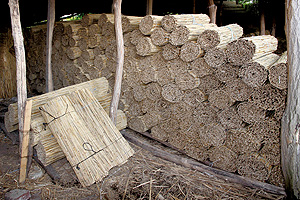 Milena Goda was born in Belgrade. Twenty years ago she moved from the capital to Belo Blato and remained there until today. We do not ask why; there are no three things under the sky that could inspire someone to make such a decision. Only two. And maybe both of them inspired her. Milena Goda was born in Belgrade. Twenty years ago she moved from the capital to Belo Blato and remained there until today. We do not ask why; there are no three things under the sky that could inspire someone to make such a decision. Only two. And maybe both of them inspired her.
”Life here is really nice, with as much as we have. Diligent and honest people. We have as many as fifteen ethnic groups here: Slovakians, Serbs, Hungarians, Roma, Romanians, Germans, even Catholic Bulgarians. Our village school is probably the only one in Serbia in which classes are held in three languages at the same time”, says Milena. ”The village is cowered at the bottom of an embankment, at the edge of the lake-pond, and at the edge of Carska bara on the other side. We are several meters below the level of the lake, and are protected only by the embankment. When the water rises, like what happened this spring and summer, we are not at ease. Some people keep their belongings packed and ready near the front door, just in case. In addition to this, even the name of our village is not accidental. Really, that is what the soil is like: dried marshland, hardened white mud. Not very fertile. Mostly reed grows here. Luckily, not just any reed, but the best reed in this part of the world.”
And it is. That is what Belo Blato is most famous for. That is why they call it a reed village. It was exactly this story that made us come here.
LIFE WITH THE REED
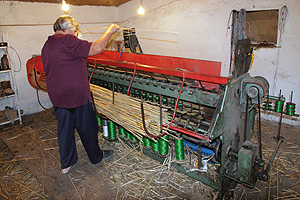 The common reed (pharagimites communis) needs wetlands. It sprouts on its own, and does not require any care or investment. It is cut after one year, because then it is the best. The common reed (pharagimites communis) needs wetlands. It sprouts on its own, and does not require any care or investment. It is cut after one year, because then it is the best.
”It is cut in the winter, until the end of March. Reed is then dry, and it is the best when it is frozen on the bottom. Then the cutter, a day laborer, does not have to walk through the mud. When he swings his đalaska (a cutting tool that looks like a sickle, or like a small scythe), the reed will not be pulled from its roots. Its bottom part will remain in the frozen clay, under the ice”, tells Marija Kuharik, whom we find on this Sunday afternoon at the machine in ”Jugotrska”, one of the two largest manufacturers and exporters of reed in Belo Blato. Marija is 56 years old, and has been working in reed processing since she was nineteen.
”That part of the work in wetlands, the harvest, is the hardest, and is done by men. Wind blows through the plains, or the frost makes everything still, or feet are buried in the mud... And one must cut enough red to make a bundle with diameter of one meter, weighing fifteen kilograms. And a few dozen times like that in a day, depending on the person. For each bundle the laborer gets 25 cents, so one can collect about ten euros a day. Those who are sturdier and stronger can make as many as fifteen”, adds Marija’s colleague Erži Halas. She is 54, and has been working on this job for 34 years. For t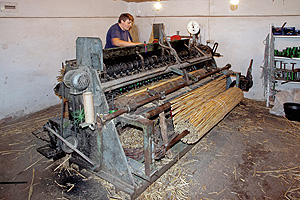 hirteen years she was doing the same job in cooperative ”Jedinstvo”, and then she moved to ”Jugotrska”. In the reed chain, women are dominant in the second to the last phase, which involves machine work hirteen years she was doing the same job in cooperative ”Jedinstvo”, and then she moved to ”Jugotrska”. In the reed chain, women are dominant in the second to the last phase, which involves machine work
When taken from the marshland, bundles are packed in cones similar to Indian tents from comic books about Tex Willer and Keith Teller. Belo Blato is full of such cones. The reed is dried, sorted, and ready to be forwarded to the machines. Machines then weave it, sow it with wire, make panels, process in accordance with the needs of the buyers. A big quantity of reed goes to the Coast, where they use it to make parasols and awnings, and it again has increasing use in construction (in the general trend of returning to natural materials). Most of it, however, is purchased by Germans.
”Reed is an excellent material for heat and sound insulation. It contains something, some natural acid, which repels bugs, mosquitoes, small rodents. It is not by accident that Western Europeans are purchasing it, their trucks are waiting in queues for a reason, they know how to take care of themselves.”
THERE WILL BE AN OPPORTUNITY
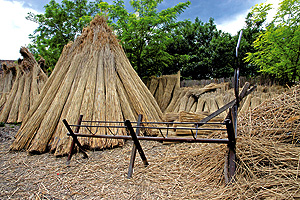 According to the reports of Agricultural Cooperative ”Jedinstvo”, the largest company for reed processing in Belo Blato (privatized today), they produce 550.000 square meters of reed at the average each year. Almost all of it goes for export. It can fit in about sixty trucks. The income amounts to about 350,000 euros. Figures are used only as an orientation, because a lot depends on a particular year, quality of the harvest, market price. According to the reports of Agricultural Cooperative ”Jedinstvo”, the largest company for reed processing in Belo Blato (privatized today), they produce 550.000 square meters of reed at the average each year. Almost all of it goes for export. It can fit in about sixty trucks. The income amounts to about 350,000 euros. Figures are used only as an orientation, because a lot depends on a particular year, quality of the harvest, market price.
Furthermore, we learn from people in Belo Blato, they cut only one third of the available reed. The rest must be burnt, so the new reed could grow better and is not mixed with the old one, which would get rotten within a year. In order to remove more reed, people need better access roads, better equipment. Some time ago we had some Dutch people here, they entered the business, brought combine harvesters for reed with wide rubber caterpillars which could easily overcome the marshland. And then they suddenly withdrew. ”For unknown reasons”, according to the accounts. ”Tulips from the north did not feel g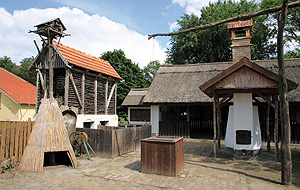 ood about the benefits of this transition. That is what they warmly recommend and selflessly leave to these Balkan tulips, which are more resistant, used to having the history that is not gentle toward them. And they collected their belongings, loaded their combine harvesters with rubber caterpillars and left without saying goodbye.” ood about the benefits of this transition. That is what they warmly recommend and selflessly leave to these Balkan tulips, which are more resistant, used to having the history that is not gentle toward them. And they collected their belongings, loaded their combine harvesters with rubber caterpillars and left without saying goodbye.”
About two thirds of the population of Belo Blato, the reed village, make their living from this wetland plant. The others live off the big fish pond nearby. Those who are today involved in processing and trade in reed as managers, used to be cutters in marshland themselves. ”They grew up in houses made of reed. That is why they know this job well and understand these people”, they say.
In this area, reed is also cut near the Tamiš, Begej, Stara Tisa, along the canals. But this one from Belo Blato is the best by far. That is what they say in Belo Blato. We did not even have the chance to ask the others. There will be an opportunity for that.
***
Storks
The nearby Carska bara is one of the biggest bird reservations in this part of Europe. As soon as you cross to this side, you will see them elegantly flying above your head. Storks and herons are dominant. Our Bosnić knows everything about them: where they perch, when they leave, what their temper is like, and how to catch them with a camera lens, how to approach them without scaring them off too soon. People in Belo Blato also know them well. Of course, they are neighbors. Storks would often move to their chimneys to build their nests, which created problems for both them and the storks. Then they got an idea and build a number of traps on top of electrical poles. They look like skeletons made of metal or wooden bars, similar to a basket or upside-down cone, appropriate for building a nest. Of course, storks would quickly recognize this and instead on a chimney, they would build their home there. That is why there are many bird homes along the streets in Belo Blato, inhabited and uninhabited, on top of electrical poles.
***
A woman from Belgrade
”I’ve told you, I was born in Belgrade and I came here twenty years ago. No, I have no regrets. I often go to visit my old friends who remained in the capital (it’s only about seventy kilometers away). They don’t understand me and, honestly, I don’t understand them. What do you get from Belgrade?! I ask them. You sit on your balconies, like in cages, drink coffee and tell always the same stories, wondering about me. You only get the negative sides of the big city, crowds, noise, neurosis, stress, crime, and if you think realistically, what benefits of the big city are you really using? It is more often that I come here for a fair, a concert or a theatre performance, than you leaving the city! Shall we count? And from here, from Belo Blato, you can get everything done, only if you are well organized. I have time to drive my kid to school in the city and for language class, and dancing and training. It is more a matter of concept, a view of the world, will, than a place of residence. On the other hand, I have a comfortable and nice life here, with a lot of space, serenity and fresh air, with a million of those small joys for which in Belgrade I would never have time.” (Milena Goda, Belo Blato)
***
You can’t believe your eyes
We look, and we can’t believe our eyes. A beautiful old Banatian house, ground floor, by the street, not far from the centre, but still sufficiently remote. Four acres of land around it: flower beds, some fruit, grass a well. Idyllic.
For sale.
Price? Two thousand euros!
We look, and we can’t believe our eyes.
|
